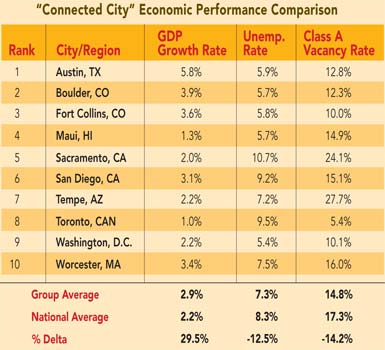Thwarting the Power Threat: Smart Buildings and Grids
Smart-grid technologies could not only prevent or alleviate outages, but also save companies money while capturing and marketing wasted energy.
Q2 / Spring 2013

Big power failures are on the rise. According to an article from the University of Minnesota College of Engineering and Science, the pace of U.S. blackouts affecting 50,000 or more electrical customers more than doubled over the past decade, from 140 during 2000–2004 to 303 during 2005–2009. The trend has continued in recent years, with 52 large blackouts in 2010 and 109 in 2011.
Rising Costs
The rise in the number of power outages is due in part to an increase in severe weather events in recent years. The additional wear and tear on equipment, plus the outdated and aging infrastructure in place in most of the country, has led to increasing power outages for most people and businesses — as well as increasing power costs.
A recent study co-conducted and reported by The Associated Press found that the average U.S. electrical customer spent 112 minutes without power in 2011, despite spending 43 percent more to maintain and repair existing infrastructure than a decade earlier. But the direct cost to address grid problems is tiny compared to the financial cost of frequent failures. The Department of Energy calculates that outages cost Americans $150 billion annually — about $500 per person every year — and some estimates are as high as $180 billion.
One of most damaging outages of 2011 affected nearly seven million people in Southern California, Arizona, and Sonora, Mexico. Originating from a field engineer’s attempt to repair a capacitor bank, the failure swept across the region, knocking out switching stations across five utilities. Many areas were without power for 12 hours, and it took 24 hours to return service to all customers.
During the power outage, the San Diego skyline went dark, cars were gridlocked for more than four hours, and several car collisions were blamed on failed traffic signals. San Diego’s trolley system and trains in Los Angeles stopped running, and one hospital lacked power for hours when its backup generator failed. A sewage treatment plant lost power and released sewage, contaminating beaches and damaging the water supply. Add to that the lost productivity of millions of workers, and the perishable inventory of thousands of restaurants and stores, and the case for smart technology makes financial sense.
Alleviating the Problem With Technology
Could smart-grid technology have prevented the 2011 outage from spreading? Could it have shortened the recovery period? Chattanooga’s Electric Power Board had just started installing 1,500 automated circuit switches and sensors on 164 circuits when nine tornados struck the area in April of 2011, knocking out power. The power authority used the 123 smart switches in service to re-route power, saving customers thousands of hours of outage time and avoiding the cost of 250 “truck rolls” for maintenance and repairs. Smart grids have cost benefits beyond preventing blackouts. Oklahoma Gas and Electric (OGE) expects implementation of smart technology to allow it to save the capital expenditure of a new power plant. The utility started time-based rates with 6,000 customers in a program that included in-home displays, web portals, and programmable communicating thermostats to reduce peak demand. The initial results led OGE to expand the program to 150,000 customers over the next several years, resulting in a 210-megawatt increase in power capacity.
Funding Matters
These and other success stories come from a Department of Energy report on its Smart Grid Investment Grant Program, which matches $3.4 billion in federal funds with an equal amount from private-sector sources to deploy 99 smart-grid projects. Among other things, the program will result in more than 15 million smart meters across the country — double the number that existed before the program, but still just a fraction of the 65 million meters estimated by industry analysts to be in place by 2015.
Smart meters are just one part of smart grid technology. A complete modernization of the national grid is expected to cost $340 billion to $480 billion, according to the DoE report. But that much and more is being lost through power outages and inefficient energy management. At a time when energy cost and carbon emissions are increasingly important considerations, companies are considering the long-term cost and reliability of energy in making their location decisions, and in smart-building automation that spans their global portfolios.
Next: Making It Work - System Compatibility & Other Factors
Project Announcements
Eos Energy Enterprises Expands Allegheny County, Pennsylvania, Operations
11/01/2025
Ahold Delhaize USA Plans Burlington, North Carolina, Distribution Operations
11/01/2025
Ulbrich Specialty Wire Products Expands Westminster, South Carolina, Production Operation
11/01/2025
Alcoa Expands Massena, New York, Operations
11/01/2025
SmartWiz Expands Birmingham, Alabama, Headquarters Operations
11/01/2025
Dutch-Based Maars North America Plans Mount Pleasant, South Carolina, Production Operations
11/01/2025
Most Read
-
2025’s Top States for Business: How the Winners Are Outpacing the Rest
Q3 2025
-
The Compliance Reckoning Is Here
Q3 2025
-
Around the Horn: Data Center Supply Chains — What's Next?
Q3 2025
-
How Consumer Trends Are Reshaping Food Facilities
Q3 2025
-
Powering the Next Generation of Projects
Q3 2025
-
First Person: Filter King’s Expansion Playbook
Q3 2025
-
Rethinking Auto Site Strategy in the Age of Tariffs and Powertrain Shifts
Q3 2025
